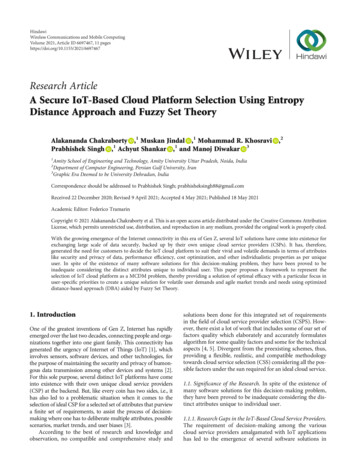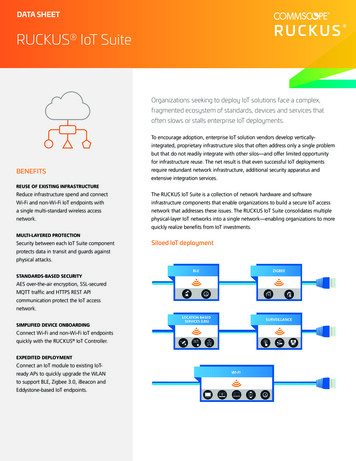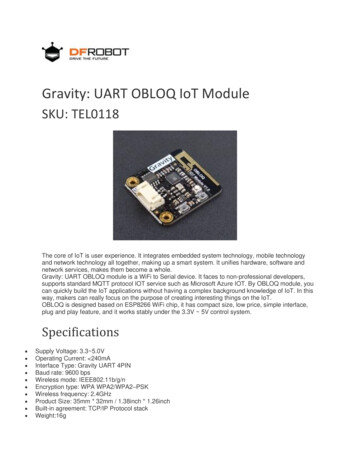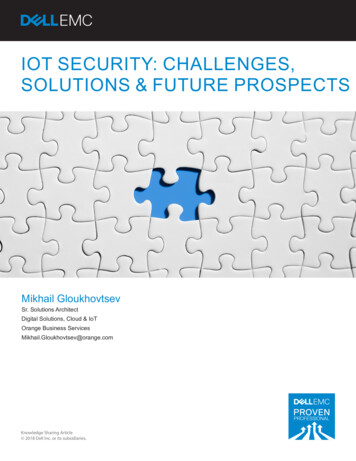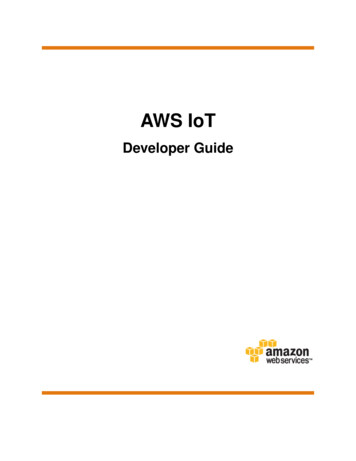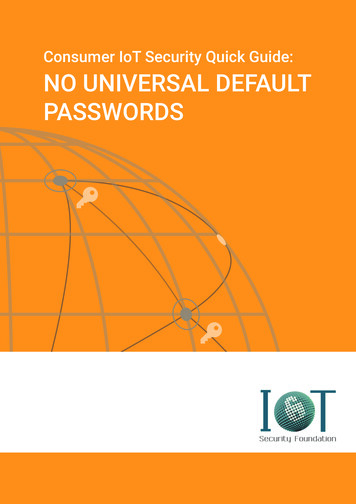
Transcription
Consumer IoT Security Quick Guide:NO UNIVERSAL DEFAULTPASSWORDS
NEW IoT PASSWORD REQUIREMENTSNo Universal Default PasswordsNew standards and regulationA newly connected IoT device is attacked within five minutes. 1 Toimprove security, new standards and upcoming regulations require IoTmanufacturers, and some importers, using passwords in their IoTproducts to ensure provided passwords are unique per device. As aresult, companies need to assess how their IoT products usepasswords.Why it matters Users are unlikely to change apassword unless forced to –increasing risks associated withuniversal passwords.Standard ETSI EN 303 6452 requires that products do not use “universaldefault passwords”. The UK Government’s Code of Practice forConsumer IoT Security3, US California Senate Bill #3274 and OregonHouse Bill #23955, and Australian Draft Code of Practice6 set outsimilar requirements. The UK government is preparing legislation whichwill prohibit the use of universal default passwords in consumer IoT.7 Universal passwords can be avulnerability for IoT devices andtheir users. Poorly managed/used passwordsput users, personal data, anddevices at risk.Important security considerations Attackers can co-opt deviceswith weak passwords, puttingnetworks and connected thingsat risk. Failure to comply with existingstandards or regulation canresult in reputational andfinancial damage.“No universal default passwords” is an important provision becausedefault passwords that are easily guessable or derivable weakensecurity. If a universal default password is used (i.e. one passwordused across multiple devices) once one device is compromised, alldevices using the same default password can be compromised. Poorpassword practices have the potential to put users’ and businesses’personal data, devices and networks at risk. Moreover, business usersof consumer IoT run the risk of financial or reputational damage. Bycontrast, good password practices help prevent unauthorised access.In some cases the elimination of passwords through the use ofalternative non-password based authentication and authorisationmechanism may be more appropriate and easier to use. Not relying onpasswords lessens the burden on users.Impact on consumer IoT manufacturersFailure to comply with existing standards or regulation can result insignificant reputational and financial damage to an IoT manufactureror importer. For instance, California Bill #327 currently sets no boundsfor financial penalties nor does it scope potential obligations (e.g.increased oversight or audits). Forthcoming UK regulation will likelyresult in sanctions, such as fines or the removal of non-compliantproducts from the market.Where to start?Below are five key questions for managers to discuss among productdevelopment, security, and compliance teams which will help on theroad to compliance with ESTI EN 303 645.2 Is using a password the best solution for our product or could astronger proven authentication mechanism be used? Do we use universal default passwords? Do we use default passwords? If we do, are theyunique-per-device and not easy to guess or derivable? Are passwords a vulnerability in our design? Do we follow industry best practices for passwords (e.g. UKNCSC8 and NIST9)?Release 1 Page 2/5 2020 IoT Security FoundationExisting standards,regulation and guidance ETSI EN 303 645 Cyber Securityfor Consumer IoT (2020)2 UK DCMS Code of Practice forConsumer IoT Security (2018) United States: California andOregon state legislation Australia Draft Code of Practice:Securing the Internet of Things Upcoming UK Regulation forConsumer IoT Security r-iot
NEW IoT PASSWORD REQUIREMENTSDos and Don’ts:Guidance on complying with new standards and regulationDosGuidelines apply to all product passwords (includingweb/API interfaces) not only user-facing passwordsDon’tsAssess if passwords are necessary for yourproduct. Understand how and why your product is usingpasswords, and determine if it is necessary or isthe best solution for the product. Understand what part(s) of the product or serviceneeds controlled access. Identify if using alternative authentication andauthorisation mechanisms will improve usabilityand security. Consider other non-password or technicalsolutions - for example, NFC, Bluetooth, biometricsor temporal proximity methods. Also considerinnovations or new specifications10 and methodssuch as OAuth for smart phones and apps.If passwords are right for your product,follow these guidelines:Default passwords Default passwords (like those pre-installed andprinted on instructions) must be unique, must notbe easily guessable, or be related to publicinformation (e.g. MAC address or Wi-Fi SSID) in anobvious way.When using pre-installed unique-per-devicepasswords, generate these with a randommechanism that reduces the risk of automatedattacks.User password management Provide a secure initial password and do not forceusers to change it during product setup. Have theuser change and/or setup passwords before thedevice can be used if a universal defaultpassword, poor password, or no password isprovided. Make sure passwords are recoverable orresettable, for example in the event of loss of aunique or secure password so that users cancontinue to use/access the product and itsfeatures. This may include resetting to an originalunique password. Users must be able to (re)set passwords ifneeded. Have a user-friendly12 and practical passwordpolicy that follows up-to-date best practices toguide users when setting sumer-iot Do not use any universal passwords(e.g. “admin/admin”). Passwords mustbe unique to each product/device. Do not use a default password unlessnecessary. If using default passwords arenecessary, they must not be derivable,for instance by using a publishedformula or serial number. Passwords must not be easilyguessable, such as a MAC address or acommonly used password like“12345”. A list of commonly used (and hacked)passwords is regularly updated andavailable at HaveIBeenPwned.com.13Keep passwords secure Protect communication and storage of passwords,for instance on the device and in transit. Industry standard methods should be used toprotect passwords when storing them ortransferring them across networks. For moreinformation, see the IoTSF Best Practice GuideRelease 2, section F on “credential management”.11Adopt best practices UK National Cyber Security Centre – PasswordGuidance: Simplifying Your Approach (2016).8 USA National Institute of Standards andTechnology (NIST) Special Publication 800-63B –Digital Identity Guidelines - Authentication andLifecycle Management (2017).9 IoT Security Foundation Best Practice Guides –Credential Management (2019).11Release 1 Page 3/5 2020 IoT Security Foundation
NEW IoT PASSWORD REQUIREMENTSThings to think about goingforwardIn addition to the basic dos and don’ts, here are a fewmore areas that need to be considered when usingpasswords in consumer IoT products.Where to go formore information?From the IoT Security Foundation IoTSF Best Practice Guides11 Make set-up and continuing passwordmanagement easy for users. IoTSF consumer IoT securitywebpage14 Build in brute-force attack protection. For examplr,limit the rate at which passwords can be tried. IoTSF’s live training webinars Consider if phasing out passwords is a viableoption for the product – and for those productsalready on the market and in use. Could securenon-password authentication be an option forfuture releases?From other bodies Japan’s IoT Security Guidelinesv1.015 Mozilla’s Don’t Get Pwned: AGuide to Safer Logins16Who should see this:It is critical that people with different roles and responsibilities are aware of default password standardsand regulations, and how they impact the organization and products. Examples of who should see thisinclude:Compliance officer: The compliance officer is responsible for how the organization respects theprinciples in this guide, standards, regulations and codes of practice.Product Manager: Buy in from the product manager is also critical. The product manager needs to seehow the product fits into existing ecosystems of IoT products (such as smart speaker systems), and toplan how the product may integrate into them. Key to all of those ecosystems is the authorization scheme.Head of Design: Designers will have to implement one or more designs for initial onboarding, and thiseffort should not be left to the end (security last), but if done early, then the security by design process willbecome a critical path. The UX evaluation does not have to occur on the real product, particularly if it usesa web interface.User Experience (UX) Manager: The initial onboarding and user authorization flow is the firstexperience every user will have. Getting this correct is critical, and this aspect of design cannot be donelater. A cross section of potential users should be considered and involved in early design phases.Head of Marketing and PR: The UX usually reports to marketing. The security flow needs to be amongthe top concerns. Getting it wrong, or leaving it too late, will reflect badly on the product and the companythat produced it.Release 1 Page 4/5 2020 IoT Security sumer-iot
NEW IoT PASSWORD REQUIREMENTSWhat are the Consumer IoT Security Quick Guides?The “Consumer IoT Security Quick Guides” identify best practices to help organisations around the worldunderstand and comply with new international standards, regulations and national guidance on consumerIoT security. These Quick Guides demystify high level language, point to additional information, andprovide different ways of thinking about or alternative approaches to consumer IoT security.The Quick Guides build upon the ETSI EN 303 6452 specification on consumer IoT cybersecurity. It is thefirst international standard of its kind. Based upon it, governments are publishing guidance17 and arepreparing legislation18 that impact companies developing, manufacturing or providing consumer IoTproducts. The Quick Guide series focuses on the top 3 issues identified in standards and guidance:passwords, vulnerability disclosure, and software t/files/2019-02/SECR 001 etsi en/303600 303699/303645/02.01.01 60/en ent data/file/773867/Code of Practice for Consumer IoT Security October illTextClient.xhtml?bill id dfThe regulatory proposals are currently subject to a public call for views and might change as a result.See //pages.nist.gov/800-63-3/sp800-63b.htmlFor example, those being developed by industry associations such as the FIDO Alliance, est-Practice-Guides-Release-2 Digitalv3.pdfFor example, letting people paste passwords ines n/2017/01/25/better-password-security/For example, the UK and AustraliaFor example, US states Oregon and California, and the UK.Copyright, Trademarks and LicensingAll product names are trademarks, registered trademarks, or service marks of their respective owners.Copyright 2020, IoT Security Foundation. All rights reserved.This work is licensed under the Creative Commons Attribution 4.0 International License. To view a copyof this license, visit Creative Commons Attribution 4.0 International License.AcknowledgementsThis guidance was commissioned by the Department for Digital, Culture, Media & Sport (DCMS) anddelivered by the IoT Security foundation in partnership with Oxford Information Labs.We wish to acknowledge significant contributions from IoTSF members to this version of the documentStacie Hoffmann and Patrick Taylor, Oxford Information LabsMichael Richardson, Sandelman Software WorksPeer reviewers:Roger Shepherd, ChiplessTrevor Hall, DisplayLinkRichard Marshall, Xitex LtdClaire Milne, independent consultantPlus others – you know who you are!In partnership withDepartment forDigital, Culture,Media & -iotRelease 1 Page 5/5 2020 IoT Security Foundation
From the IoT Security Foundation IoTSF Best Practice Guides11 IoTSF consumer IoT security webpage14 IoTSF's live training webinars From other bodies Japan's IoT Security Guidelines v1.015 Mozilla's Don't Get Pwned: A Guide 16to Safer Logins In addition to the basic dos and don'ts, here are a few

